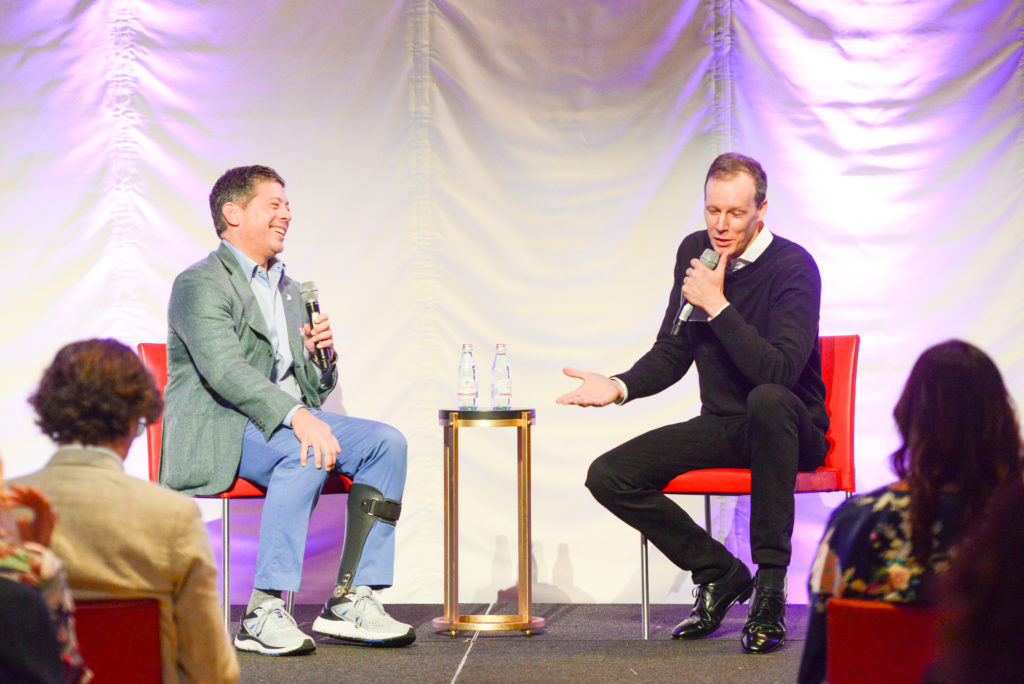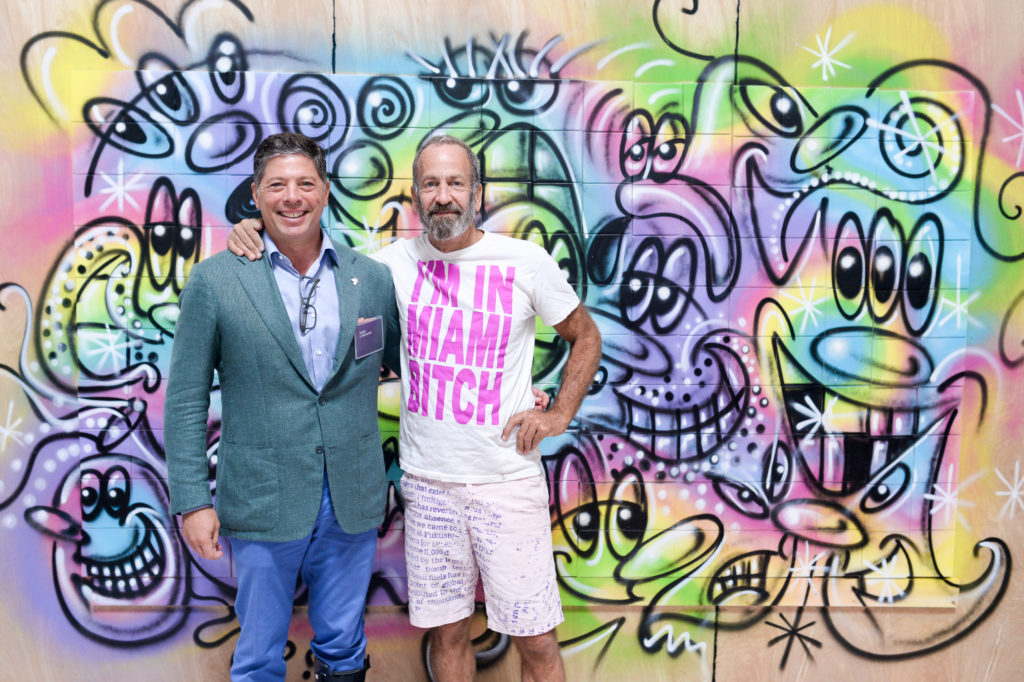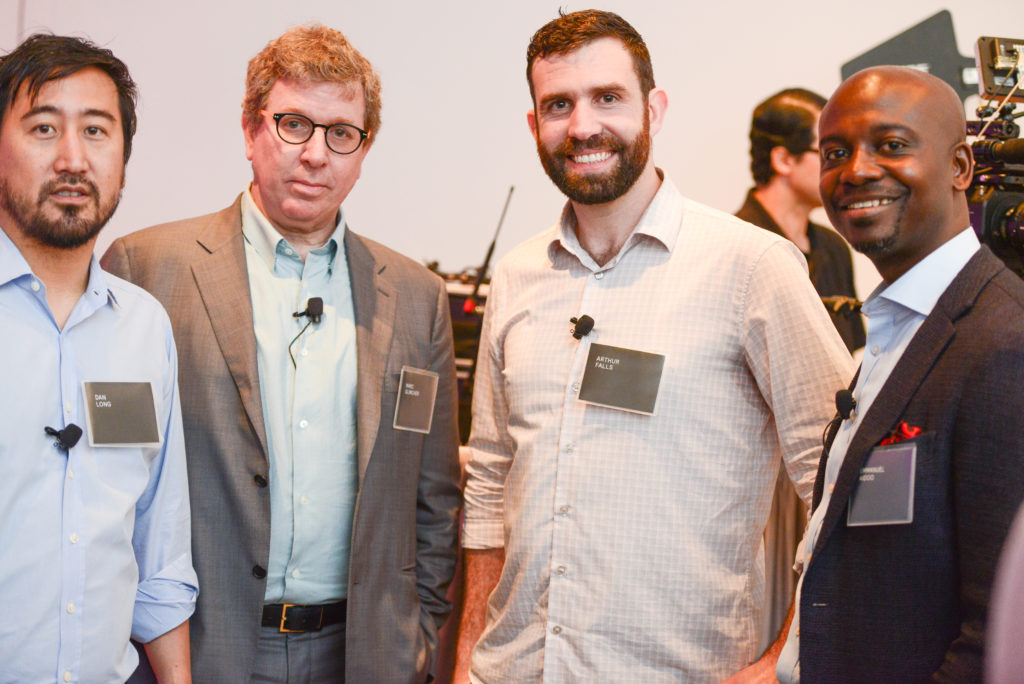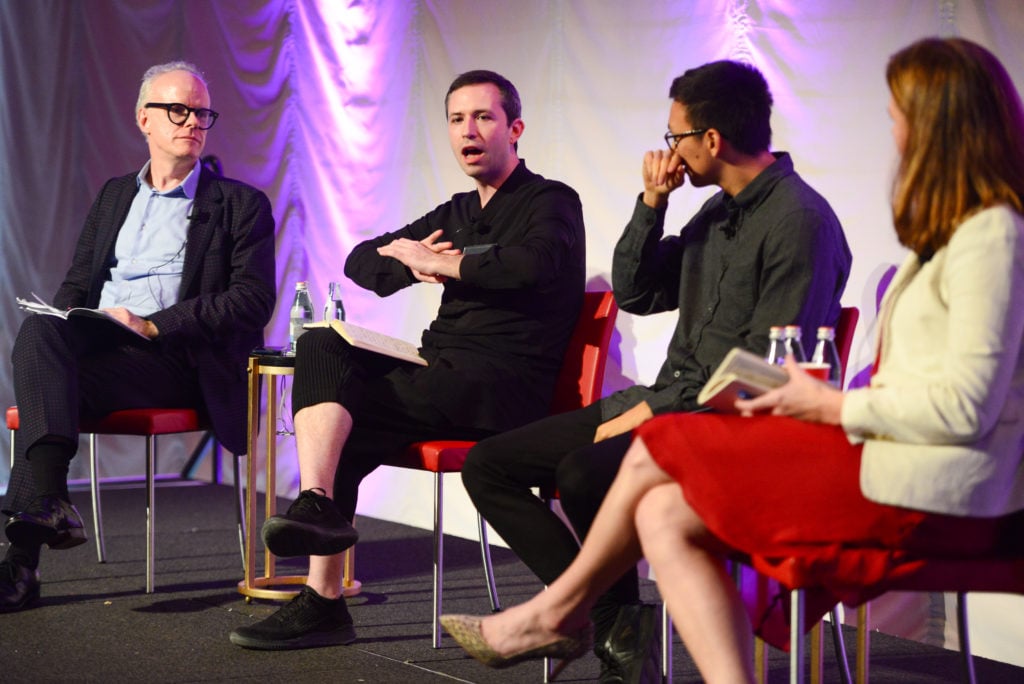Nearly halfway through “The Art of Blockchains,” the star-studded, half-day conference hosted by billionaire collector, gallerist, and entrepreneur Adam Lindemann to explore the art world’s awkward romance with blockchain technology, New Museum director Lisa Phillips succinctly verbalized the fundamental tension haunting the shared space. “We’ve heard a lot about value,” she said, “but not a lot about values.”
Phillips was only referring to the two discussions that preceded her own panel in the day’s program. But her observation cut through some of the ambient hype and to the heart of the major question that needs to be addressed if this technology—or any other—can ever yield a transformational future for the art market.
After an occasionally revelatory, sometimes-exasperating, frequently surreal five hours, the conference deserves credit for surfacing truly foundational questions about art’s relationship to innovation, especially among an art-world guest list that would otherwise rarely, if ever, engage on these specific terms. It united, among others, Phillips and Museum of Modern Art curator Stuart Comer with guests like Pace vice president Adam Sheffer and Armory Show director Nicole Berry.
Just how many attendees registered the dramatic scale of the implications, let alone walked away willing to take action because of them, remains the most relevant question.

New Museum director Lisa Phillips and Adam Lindemann.
Viewfinders
To say that blockchain has been a popular topic in the art world this year would be a laughable understatement—indeed, this wasn’t even the only major blockchain confab of the week.
Eventbrite lists an all-week “Blockchain World Conference,” not particularly art-focused but “strategically tied to the art basel festival in Miami which will attract High Net Worth individuals from all over the globe.” Elsewhere, for a ticket price listed as between $125 and $1,075, you could have gone to an “investor and entrepreneur networking event” called “Bitcoin Mansion” in the Design District. And tomorrow, at Nikki Beach Club, yet another event, dubbed “Art Decentralized,” promises a keynote by the artist known only as VESA.
“The Art of Blockchains” was far and away the most reputable of these events. It featured an unexpected diversity of high-level participants due in no small part to Lindemann’s involvement. He said in his introductory remarks that he has studied the technology for over a year and, during that process, has become an investor in multiple blockchain ventures, including Artblx, which organized the conference.
With a handful of welcome exceptions, the most consistent, nagging issue running through the various conversations in “The Art of Blockchains” had little to do with the specific limits or capacities of the technology itself. To my eyes and ears, it was actually about the drastic extent to which, even for very intelligent people, personal incentives can often harden a worldview and limit the imagination.
This is hardly a problem exclusive to those of us (myself included) who attended the conference. Author Chuck Klosterman has written an impish, eye-opening book about this phenomenon titled But What If We’re Wrong?: Thinking About the Present As If It Were the Past. In it, he tours readers through multiple thought exercises proceeding from the premise that what is obvious in retrospect is often unfathomable in the moment—and vice versa.
That very human fallacy tends to be especially powerful within closed, niche groups. Just think of the aggressive (and heartening) re-evaluation of modern and postwar art now elevating the revolutionary contributions of women, people of color, and non-Westerners. If we all agree that this revision is so long overdue, why didn’t our predecessors realize it at the time? More discomfiting, what might be happening right now that we ourselves cannot begin to process?

Adam Lindemann and Square co-founder Jim McKelvey during a “fireside chat.” Photo credit: Madison McGaw/BFA.com.
I raise this issue because several of the conference’s speakers seemed almost militantly oblivious to the prospect that other art lovers and potential art lovers—the untold thousands of people whose interactions with art, they contend, will be transformed by blockchains—might have radically different wants and needs than the ones that would satisfy their respective business plans. This was the obstacle Lisa Phillips targeted with her line about value versus values.
Her comment seemed motivated by the day’s first panel, where legitimately progressive ideas—building communities within a digital commons, meaningfully expanding the audience for art, finding sustainable ways to fund traditionally market-resistant media—emerged, only to be sidelined time and again by the supposed allure of “participating in art” through fractional ownership and tokenizing great works to “release liquidity” bottled up inside them, as if we were discussing the need to frack shale formations during an OPEC tantrum. Although plenty of big checks will change hands during Miami Art Week, far more people are here to see art and go to art-related parties than to actually buy art, making the rhetorical dominance of transaction-based art experiences throughout the day seem especially dissonant with the realities on the ground.
Similarly, speaker after speaker invoked the idea that blockchain was already a “disruptive technology,” and that its base-level reformation of the art trade was “inevitable”—the most revered term in Silicon Valley’s techno-capitalist dialect. Yet what blockchain has actually accomplished to date to deserve the anointing oils remains mysterious to the average citizen, besides flooding their daily experience with breathless evangelism about how blockchain and cryptocurrencies will change their lives. So far, it is less a triumph of technology than of tautology.

A “physical Bitcoin” (which is sort of a gimmick, but exists). Photo Illustration by Thomas Trutschel/Photothek via Getty Images.
Alternative History
Blockchain’s defenders would say that I’m demanding results too soon. But how long do we have to wait? While the popular genesis of cryptoculture was the appearance of Satoshi Nakomoto’s 2008 Bitcoin white paper, NYU professor Amy Whitaker pointed out later in the day that a paper detailing the underlying technology had actually been published by scientists Stuart Haber and Scott Stornetta all the way back in 1991. In short, we have had the blueprint for blockchain for 27 years, and at present, the manifestation that has reached furthest into the zeitgeist is Bitcoin, a currency that promises decentralization but has delivered a state of affairs in which 97 percent of all Bitcoin value is siloed with just four percent of Bitcoin wallet addresses, according to a Credit Suisse report earlier this year.
Granted, the art industry has only gotten started with blockchain in the past few years—late as usual, when it comes to tech—and our industry could be uniquely suited to capitalize on this technology via potential use cases like time-stamped title registries and smart contracts. But there was precious little discussion in “The Art of Blockchains” of the possibility that blockchain may simply be flawed technology, a prospect that would explain why its hype started dying out in the earlier-adopting business world months ago, and a recent study of 43 blockchain-based ventures “found no documentation or evidence of the results blockchain was purported to have achieved,” according to USAID fellow John Burg and colleagues.
To his credit, Nanne Dekking of blockchain title registry Artory spoke to this inconvenient truth in the day’s first panel by offering that he knew of “only one company with a successful blockchain use case” to date: shipping titan Maersk, which uses the technology to verify its supply chain. Yet his co-panelist, Emmanuel Aidoo, Credit Suisse’s remarkably titled “Head of Distributed Ledger Technology,” immediately scoffed, claiming that he personally runs 17 blockchain projects. He could not, however, tell us anything about them, because, in his words, “We are not public about everything we do.”
Similarly, in a thoroughly surreal “fireside chat” with Lindemann, Square co-founder Jim McKelvey began by asking whether the room would obey Chatham House Rule by anonymizing his statements if we were to write or post about them. The room said “no,” and here we are.
This odd cloak-and-dagger veneer from Aidoo and McKelvey was eerily reminiscent of the findings of that aforementioned 0-for-43 blockchain study, in which its authors said that they were unable to elicit responses through direct inquiries to any of the ventures they looked into. “Despite all the hype about how blockchain will bring unheralded transparency to processes and operations in low-trust environments, the industry is itself opaque.” The irony is thicker than the air before a South Beach thunderstorm.

Adam Lindemann with Kenny Scharf in front of Scharf’s live painting made during the Art of Blockchains luncheon.
PHOTO CREDIT: Madison McGaw/BFA.com.
Of Arsonists and Firefighters
Such reflections bring us to a crucial possibility raised by Whitaker: that too many people in the art-and-blockchain space are expecting a technological innovation to solve fundamentally human problems. Even the most elegant software can’t change a thing if the people involved don’t want that change to take place.
Change demands that extraordinary (and extraordinarily rare) individuals commit themselves to something that actively works against their own incentives for the sake of a greater good. To borrow a metaphor from Anand Giridharadas, whose book Winners Take All interrogates the surprisingly widespread belief that we can and should trust plutocrats (many of them rich from Big Tech) to “change the world” for the better when they are the people benefiting so disproportionately from the way the world works now, this baseline assumption is as misguided as relying on arsonists to be firefighters.
Still, that particular formulation feels too harsh to me here. The issue at “The Art of Blockchains” was less malice than myopia. People with careers in art or careers in tech tend only to see what they’ve been trained to see. But regardless of the difference in animating force, the results at the conference were the same as in Giridharadas’s formulation: As ever, the people offering the most disruptive and transformative ideas about blockchain’s potential were almost invariably the ones with the least power to implement them.
Notions of power also came to the fore through artist and Serpentine Galleries chief technology officer Ben Vickers. In the day’s final panel (alongside Whitaker), he broke from previous presenters by stressing the need to understand the actual technological details of blockchain. Why? Because the details reveal crucial information about who holds the otherwise-invisible power in an allegedly decentralized system. (For more details, just look deeper at blockchain-based fractional ownership.)
By contrast, the opening panel’s moderator happily bypassed the ins and outs of the technology once most members of the audience raised a hand to confirm they had previously heard of blockchain. And in his aforementioned “fireside chat” with Lindemann, McKelvey repeatedly hammered on the idea that the technological details would simply put everyone to sleep. (What very much woke up the people in my row was McKelvey’s backfiring joke that an artist is “somebody who sells something no one else needs,” en route to a monologue endorsing blockchain’s importance to the art world by way of his own practice as a blown-glass artist.)

Artblx co-founder and CEO Dan Long, Pace President and CEO Marc Glimcher, moderator Arthur Falls, and Credit Suisse’s Emmanuel Aidoo. Photo credit: Madison McGaw/BFA.com.
The Light at the End of the Chain?
Nevertheless, there were pleasant surprises. Chief among them was Pace president and CEO Marc Glimcher, who did something vanishingly rare for a dealer in his position: admitting that the traditional art market had failed progressive artists in the past. He voiced this idea in the context of performance art, which he argued had essentially rendered painting irrelevant in the 1970s—until dealers’ inability to find a sustainable economic model for its proponents undid the medium from the inside.
However, Glimcher went further by trumpeting proof of concept for an alternative model in Pace’s recent history. He claimed that the gallery sold one million timed tickets, at $20 each, during Japanese media collective teamLab’s 14-month exhibition at Pace’s (since-closed) Menlo Park pop-up space. He also estimated that only about 10 percent of teamLab’s revenue came from selling installations, while the other 90 percent came from ticket sales.
This triumph and other evidence from Pace’s Bay Area presence (which continues via a permanent Palo Alto space) led Glimcher to declare to the audience, “Either we’re going to amend our model, or they”—meaning the next generation—“are going to do it for us.”
Whitaker, the NYU professor, alluded to a similar concept during the day’s final panel. There, she raised the possibility that the real disruptive technology within the art-and-blockchain Venn diagram was not the technology itself but rather the galvanizing opportunity for “artists acting as an organized whole” to secure their own rights. She expressed optimism about this union stemming from her belief that people are “inherently generous”—though at the self-admitted risk of naivete.
A Picture That Spoke 1,000 Words
And yet, souring this moment of hope at the conference’s close was an incident that served, in my mind, as the most indelible sight of the day.
Earlier, during a seated luncheon inside the convention center, spray-can maestro Kenny Scharf had created a live painting on a surface composed of 100 small canvases. The concept, as Lindemann explained to Bloomberg before the event, was for “every attendee to get a piece” as “a metaphor for blockchain: It’s meant to be shared.”
But that is not how things played out.
Shortly after Scharf completed his work, with no announcement, a splinter group of attendees descended on the painting and began tearing small canvases out of the matrix for themselves. Others in the room quickly abandoned their plates to charge into the scrum. The rest of us stared in awe as our former tablemates, so refined and docile moments earlier, created a 20-deep feeding frenzy for the remaining parcels of unclaimed property. Among them, a tall, bearded man with a Samson-like mane wading back through the crowd, clutching three canvases to his chest like battlefield trophies, head thrown back in laughter.
Although there were a few gift bags with pieces of Scharf’s work waiting at the check-in table outside the conference room as we returned for the afternoon’s sessions, in the end, the symbolic painting was not evenly distributed. The most aggressive and opportunistic carted away an outsized share of the gains.
As metaphors for blockchain go, I venture to guess this was not the one that Lindemann hoped for. If the highest ranks of the art world are willing to face up to the dysfunction and self-interest it revealed, then “The Art of Blockchains” could still be a historic moment regardless of the underlying technology’s fate. But as with so much else in the blockchain space, that’s a colossal “if.”














